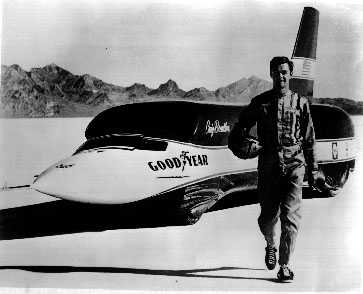 When I was a kid I was fascinated by jet cars. One of my childhood idols was Craig Breedlove - the first human to drive past 400, 500, and 600 MPH.
When I was a kid I was fascinated by jet cars. One of my childhood idols was Craig Breedlove - the first human to drive past 400, 500, and 600 MPH.In those days my cousin and I had a lot of model rockets as well - made by Estes and Century. We also had wooden airplanes made from balsa wood powered by Jetex engines.
But real rocket and jet cars were never very far away. Where I grew up we lived about five miles from the Great Lakes Dragway. On Friday and Saturday summer nights you could hear the announcers talking and, best of all, you could hear the dragsters.
Of particular interest to me was the Green Monster - a dragster built and driven by Art Arfons. You could hear it start up, its jet engine roaring, and hear it run down the track. One year my grade school friends family took me to the drag strip. The Green Monster was there but it didn't run that day.
However, I was able to see a rocket car using a Gemini spacecraft reentry motor. This was a small aluminum framed car with a rocket nozzle protruding from the back. Like the Estes and jetex motors of the time it was a simple, solid fuel engine. It did a nice job of taking the car down the track.
Given all of this excitement what could a geek child do but build his own rocket car.
Of course, building one large enough to ride in was out of the question at that point - so instead I tried the next best thing. I sat down with my X-acto knife, some Estes rocket parts and some sheets of balsa wood and rubber airplane wheels purchased from the local hobby shop and I built my own.
It was designed along the lines of the Spirit of America pictured above - or at least as close to that as my ten-year-old fingers could manage. It had four wheels and a tail and was powered by a standard model rocket engine.
The only problem I could foresee was how to make it run in a straight line.
For that I borrowed a concept from CO2 rocket cars. These were small metal cars into which you would put a CO2 pellet gun cartridge. They came with a little spring-loaded "starter" that had a sharp needle on one end. You put this up to the CO2 cartridges throat, pulled back the trigger, and let it sprint forward to pierce the metal cap holding in the gas. I had one of these cars at some point but the cartridges were expensive, at least compared to rocket motors at the time, and were a pain to acquire.
The cars ran on a string and since we were fortunate enough to have an asphalt driveway the solution was to simply put two nails in at each end and run a string down the middle.
All of this violated the Model Rocket Code of Ethics, of course, but since it was done in the name of science I figured it was okay to bend the rules.
Another rule we bent was using jetex fuses to light the motors. You were supposed to have a battery-based ignition system with a safety key and so forth - but keeping a charged batter around was a tough job and the fuses were much more reliable in practice.
The maiden run of the car was successful, but since it was top heavy it tipped over near the end.
My cousin, upon hearing this, built his own version and on subsequent visits we were able to run our cars.
Eventually my car was retired to my model car shelf were it sat until I moved away to go to college.
After Breelove came the "Blue Flame" in about 1970. This was a rocket car that used natural gas run by Gary Gabelich.
This car pushed the land speed record up to around 622 MPH.
It wasn't until 27 years later in 1997 that Thrust SSC finally pushed the land speed record beyond the speed of sound.
Today Richard Noble is working on a car that he hopes to drive in excess of 1,000 MPG - the Bloodhound SSC. This car is powered by both a jet and rocket engine - the jet being used to get things rolling and the rocket to boost the speed from there.
For me, retiring from this business at age 10 or so was a good idea. Rocket cars are an expensive hobby regardless of age and, as an adult, there is the added danger of having a wreck.
Cars at higher speeds are really just airfoils and they tend to have too much lift. This means that your front steering wheel wants to lift up off the ground. Since, unlike my cars, these don't run on strings nailed to the road, that can be a problem.
But I guess some people haven't quite figured all this out...

No comments:
Post a Comment